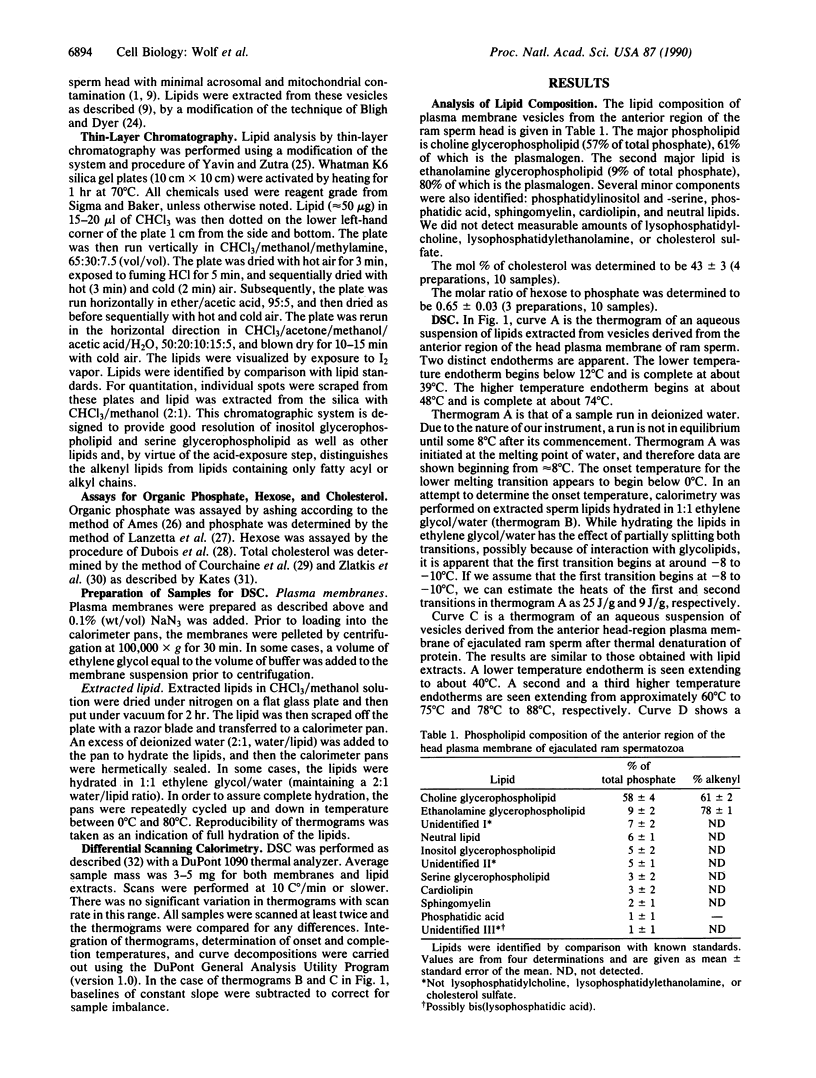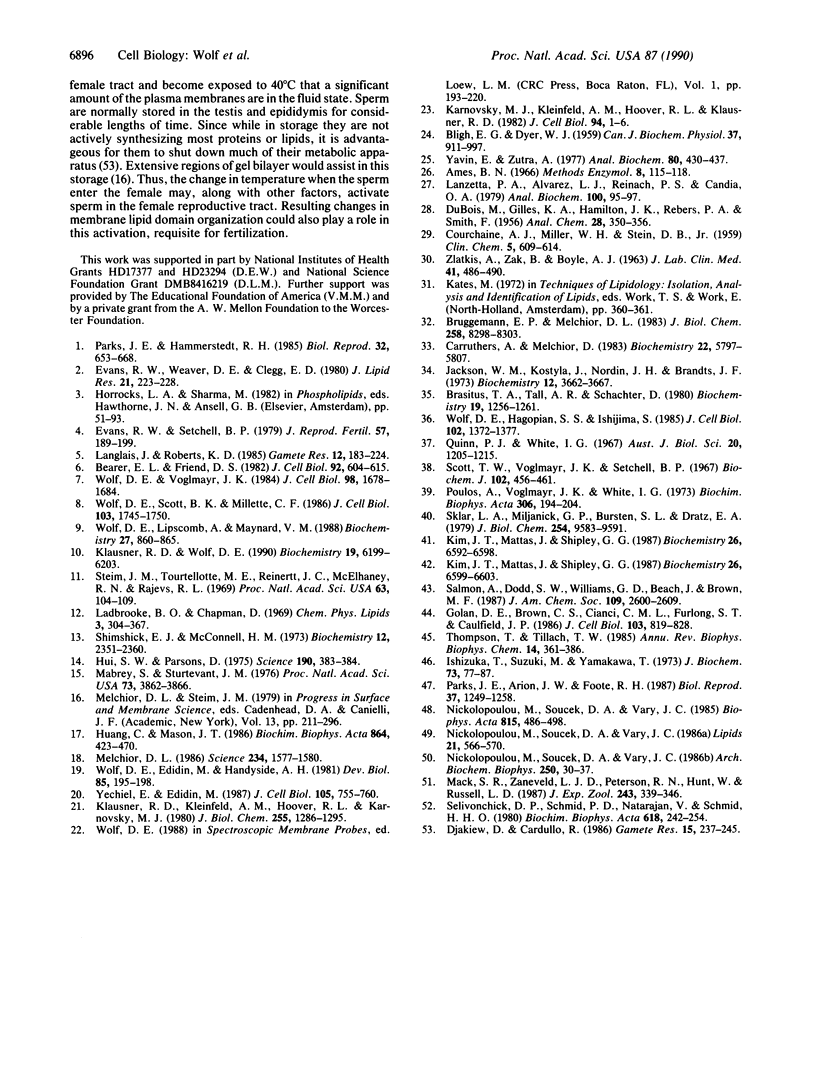Abstract
Mammalian sperm plasma membranes, in contrast to those of mammalian somatic cells, exhibit a significant fraction of lipid that does not diffuse laterally in the plane of the membrane. This nondiffusing fraction results from lipid-lipid interactions. Similar nondiffusing fractions are found in mixed-lipid model systems that contain coexistent gel and fluid domains. These results suggest that the sperm plasma membrane may also exhibit lateral phase segregations of lipids and may contain significant amounts of gel-phase lipid. In this paper we use differential scanning calorimetry to show that, in contrast to the plasma membranes of mammalian somatic cells, the plasma membrane from the anterior region of the head of ram sperm exhibits at least two major endothermic transitions, one centered at approximately 26 degrees C and one centered at approximately 60 degrees C. The heats of these transitions are consistent with gel-to-fluid transitions in model membranes. These transitions are observed both in plasma membrane vesicles and in rehydrated lipid extracts made from these vesicles. These results demonstrate that at physiological temperatures the lipids of the ram sperm plasma membrane are segregated into coexistent fluid and gel domains. Since sperm encounter a wide range of temperatures during their development, these phase transitions may be important in establishing dynamic domains of lipid requisite for epididymal storage and fertilization.
Full text
PDF



Selected References
These references are in PubMed. This may not be the complete list of references from this article.
- BLIGH E. G., DYER W. J. A rapid method of total lipid extraction and purification. Can J Biochem Physiol. 1959 Aug;37(8):911–917. doi: 10.1139/o59-099. [DOI] [PubMed] [Google Scholar]
- Bearer E. L., Friend D. S. Modifications of anionic-lipid domains preceding membrane fusion in guinea pig sperm. J Cell Biol. 1982 Mar;92(3):604–615. doi: 10.1083/jcb.92.3.604. [DOI] [PMC free article] [PubMed] [Google Scholar]
- Brasitus T. A., Tall A. R., Schachter D. Thermotropic transitions in rat intestinal plasma membranes studied by differential scanning calorimetry and fluorescence polarization. Biochemistry. 1980 Mar 18;19(6):1256–1261. doi: 10.1021/bi00547a033. [DOI] [PubMed] [Google Scholar]
- Bruggemann E. P., Melchior D. L. Alterations in the organization of phosphatidylcholine/cholesterol bilayers by tetrahydrocannabinol. J Biol Chem. 1983 Jul 10;258(13):8298–8303. [PubMed] [Google Scholar]
- COURCHAINE A. J., MILLER W. H., STEIN D. B., Jr Rapid semi-micro procedure for estimating free and total cholesterol. Clin Chem. 1959 Dec;5:609–614. [PubMed] [Google Scholar]
- Evans R. W., Setchell B. P. Lipid changes in boar spermatozoa during epididymal maturation with some observations on the flow and composition of boar rete testis fluid. J Reprod Fertil. 1979 Sep;57(1):189–196. doi: 10.1530/jrf.0.0570189. [DOI] [PubMed] [Google Scholar]
- Evans R. W., Weaver D. E., Clegg E. D. Diacyl, alkenyl, and alkyl ether phospholipids in ejaculated, in utero-, and in vitro-incubated porcine spermatozoa. J Lipid Res. 1980 Feb;21(2):223–228. [PubMed] [Google Scholar]
- Golan D. E., Brown C. S., Cianci C. M., Furlong S. T., Caulfield J. P. Schistosomula of Schistosoma mansoni use lysophosphatidylcholine to lyse adherent human red blood cells and immobilize red cell membrane components. J Cell Biol. 1986 Sep;103(3):819–828. doi: 10.1083/jcb.103.3.819. [DOI] [PMC free article] [PubMed] [Google Scholar]
- Huang C., Mason J. T. Structure and properties of mixed-chain phospholipid assemblies. Biochim Biophys Acta. 1986 Dec 22;864(3-4):423–470. doi: 10.1016/0304-4157(86)90005-5. [DOI] [PubMed] [Google Scholar]
- Hui S. W., Parsons D. F. Direct observation of domains in wet lipid bilayers. Science. 1975 Oct 24;190(4212):383–384. doi: 10.1126/science.1179216. [DOI] [PubMed] [Google Scholar]
- Ishizuka I., Suzuki M., Yamakawa T. Isolation and characterization of a novel sulfoglycolipid, 'seminolipid,' from boar testis and spermatozoa. J Biochem. 1973 Jan;73(1):77–87. [PubMed] [Google Scholar]
- Jackson W. M., Kostyla J., Nordin J. H., Brandts J. F. Calorimetric study of protein transitions in human erythrocyte ghosts. Biochemistry. 1973 Sep 11;12(19):3662–3667. doi: 10.1021/bi00743a014. [DOI] [PubMed] [Google Scholar]
- Karnovsky M. J., Kleinfeld A. M., Hoover R. L., Klausner R. D. The concept of lipid domains in membranes. J Cell Biol. 1982 Jul;94(1):1–6. doi: 10.1083/jcb.94.1.1. [DOI] [PMC free article] [PubMed] [Google Scholar]
- Kim J. T., Mattai J., Shipley G. G. Bilayer interactions of ether- and ester-linked phospholipids: dihexadecyl- and dipalmitoylphosphatidylcholines. Biochemistry. 1987 Oct 20;26(21):6599–6603. doi: 10.1021/bi00395a006. [DOI] [PubMed] [Google Scholar]
- Kim J. T., Mattai J., Shipley G. G. Gel phase polymorphism in ether-linked dihexadecylphosphatidylcholine bilayers. Biochemistry. 1987 Oct 20;26(21):6592–6598. doi: 10.1021/bi00395a005. [DOI] [PubMed] [Google Scholar]
- Klausner R. D., Kleinfeld A. M., Hoover R. L., Karnovsky M. J. Lipid domains in membranes. Evidence derived from structural perturbations induced by free fatty acids and lifetime heterogeneity analysis. J Biol Chem. 1980 Feb 25;255(4):1286–1295. [PubMed] [Google Scholar]
- Klausner R. D., Wolf D. E. Selectivity of fluorescent lipid analogues for lipid domains. Biochemistry. 1980 Dec 23;19(26):6199–6203. doi: 10.1021/bi00567a039. [DOI] [PubMed] [Google Scholar]
- Ladbrooke B. D., Chapman D. Thermal analysis of lipids, proteins and biological membranes. A review and summary of some recent studies. Chem Phys Lipids. 1969 Dec;3(4):304–356. doi: 10.1016/0009-3084(69)90040-1. [DOI] [PubMed] [Google Scholar]
- Lanzetta P. A., Alvarez L. J., Reinach P. S., Candia O. A. An improved assay for nanomole amounts of inorganic phosphate. Anal Biochem. 1979 Nov 15;100(1):95–97. doi: 10.1016/0003-2697(79)90115-5. [DOI] [PubMed] [Google Scholar]
- Mabrey S., Sturtevant J. M. Investigation of phase transitions of lipids and lipid mixtures by sensitivity differential scanning calorimetry. Proc Natl Acad Sci U S A. 1976 Nov;73(11):3862–3866. doi: 10.1073/pnas.73.11.3862. [DOI] [PMC free article] [PubMed] [Google Scholar]
- Mack S. R., Zaneveld L. J., Peterson R. N., Hunt W., Russell L. D. Characterization of human sperm plasma membrane: glycolipids and polypeptides. J Exp Zool. 1987 Aug;243(2):339–346. doi: 10.1002/jez.1402430219. [DOI] [PubMed] [Google Scholar]
- Melchior D. L. Lipid domains in fluid membranes: a quick-freeze differential scanning calorimetry study. Science. 1986 Dec 19;234(4783):1577–1580. doi: 10.1126/science.3787264. [DOI] [PubMed] [Google Scholar]
- Nikolopoulou M., Soucek D. A., Vary J. C. Changes in the lipid content of boar sperm plasma membranes during epididymal maturation. Biochim Biophys Acta. 1985 May 28;815(3):486–498. doi: 10.1016/0005-2736(85)90377-3. [DOI] [PubMed] [Google Scholar]
- Nikolopoulou M., Soucek D. A., Vary J. C. Lipid composition of the membrane released after an in vitro acrosome reaction of epididymal boar sperm. Lipids. 1986 Sep;21(9):566–570. doi: 10.1007/BF02534053. [DOI] [PubMed] [Google Scholar]
- Nikolopoulou M., Soucek D. A., Vary J. C. Modulation of the lipid composition of boar sperm plasma membranes during an acrosome reaction in vitro. Arch Biochem Biophys. 1986 Oct;250(1):30–37. doi: 10.1016/0003-9861(86)90698-3. [DOI] [PubMed] [Google Scholar]
- Parks J. E., Arion J. W., Foote R. H. Lipids of plasma membrane and outer acrosomal membrane from bovine spermatozoa. Biol Reprod. 1987 Dec;37(5):1249–1258. doi: 10.1095/biolreprod37.5.1249. [DOI] [PubMed] [Google Scholar]
- Parks J. E., Hammerstedt R. H. Development changes occurring in the lipids of ram epididymal spermatozoa plasma membrane. Biol Reprod. 1985 Apr;32(3):653–668. doi: 10.1095/biolreprod32.3.653. [DOI] [PubMed] [Google Scholar]
- Poulos A., Voglmayr J. K., White I. G. Phospholipid changes in spermatozoa during passage through the genital tract of the bull. Biochim Biophys Acta. 1973 May 24;306(2):194–202. doi: 10.1016/0005-2760(73)90225-7. [DOI] [PubMed] [Google Scholar]
- Quinn P. J., White I. G. Phospholipid and cholesterol content of epididymal and ejaculated ram spermatozoa and seminal plasma in relation to cold shock. Aust J Biol Sci. 1967 Dec;20(6):1205–1215. doi: 10.1071/bi9671205. [DOI] [PubMed] [Google Scholar]
- Scott T. W., Voglmayr J. K., Setchell B. P. Lipid composition and metabolism in testicular and ejaculated ram spermatozoa. Biochem J. 1967 Feb;102(2):456–461. doi: 10.1042/bj1020456. [DOI] [PMC free article] [PubMed] [Google Scholar]
- Selivonchick D. P., Schmid P. C., Natarajan V., Schmid H. H. Structure and metabolism of phospholipids in bovine epididymal spermatozoa. Biochim Biophys Acta. 1980 May 28;618(2):242–254. doi: 10.1016/0005-2760(80)90030-2. [DOI] [PubMed] [Google Scholar]
- Shimshick E. J., McConnell H. M. Lateral phase separation in phospholipid membranes. Biochemistry. 1973 Jun 5;12(12):2351–2360. doi: 10.1021/bi00736a026. [DOI] [PubMed] [Google Scholar]
- Sklar L. A., Miljanich G. P., Bursten S. L., Dratz E. A. Thermal lateral phase separations in bovine retinal rod outer segment membranes and phospholipids as evidenced by parinaric acid fluorescence polarization and energy transfer. J Biol Chem. 1979 Oct 10;254(19):9583–9591. [PubMed] [Google Scholar]
- Steim J. M., Tourtellotte M. E., Reinert J. C., McElhaney R. N., Rader R. L. Calorimetric evidence for the liquid-crystalline state of lipids in a biomembrane. Proc Natl Acad Sci U S A. 1969 May;63(1):104–109. doi: 10.1073/pnas.63.1.104. [DOI] [PMC free article] [PubMed] [Google Scholar]
- Thompson T. E., Tillack T. W. Organization of glycosphingolipids in bilayers and plasma membranes of mammalian cells. Annu Rev Biophys Biophys Chem. 1985;14:361–386. doi: 10.1146/annurev.bb.14.060185.002045. [DOI] [PubMed] [Google Scholar]
- Wolf D. E., Edidin M., Handyside A. H. Changes in the organization of the mouse egg plasma membrane upon fertilization and first cleavage: indications from the lateral diffusion rates of fluorescent lipid analogs. Dev Biol. 1981 Jul 15;85(1):195–198. doi: 10.1016/0012-1606(81)90250-5. [DOI] [PubMed] [Google Scholar]
- Wolf D. E., Hagopian S. S., Ishijima S. Changes in sperm plasma membrane lipid diffusibility after hyperactivation during in vitro capacitation in the mouse. J Cell Biol. 1986 Apr;102(4):1372–1377. doi: 10.1083/jcb.102.4.1372. [DOI] [PMC free article] [PubMed] [Google Scholar]
- Wolf D. E., Lipscomb A. C., Maynard V. M. Causes of nondiffusing lipid in the plasma membrane of mammalian spermatozoa. Biochemistry. 1988 Feb 9;27(3):860–865. doi: 10.1021/bi00403a004. [DOI] [PubMed] [Google Scholar]
- Wolf D. E., Scott B. K., Millette C. F. The development of regionalized lipid diffusibility in the germ cell plasma membrane during spermatogenesis in the mouse. J Cell Biol. 1986 Nov;103(5):1745–1750. doi: 10.1083/jcb.103.5.1745. [DOI] [PMC free article] [PubMed] [Google Scholar]
- Wolf D. E., Voglmayr J. K. Diffusion and regionalization in membranes of maturing ram spermatozoa. J Cell Biol. 1984 May;98(5):1678–1684. doi: 10.1083/jcb.98.5.1678. [DOI] [PMC free article] [PubMed] [Google Scholar]
- Yavin E., Zutra A. Separation and analysis of 32P-labeled phospholipids by a simple and rapid thin-layer chromatographic procedure and its application to cultured neuroblastoma cells. Anal Biochem. 1977 Jun;80(2):430–437. doi: 10.1016/0003-2697(77)90665-0. [DOI] [PubMed] [Google Scholar]
- Yechiel E., Edidin M. Micrometer-scale domains in fibroblast plasma membranes. J Cell Biol. 1987 Aug;105(2):755–760. doi: 10.1083/jcb.105.2.755. [DOI] [PMC free article] [PubMed] [Google Scholar]
- ZLATKIS A., ZAK B., BOYLE A. J. A new method for the direct determination of serum cholesterol. J Lab Clin Med. 1953 Mar;41(3):486–492. [PubMed] [Google Scholar]


